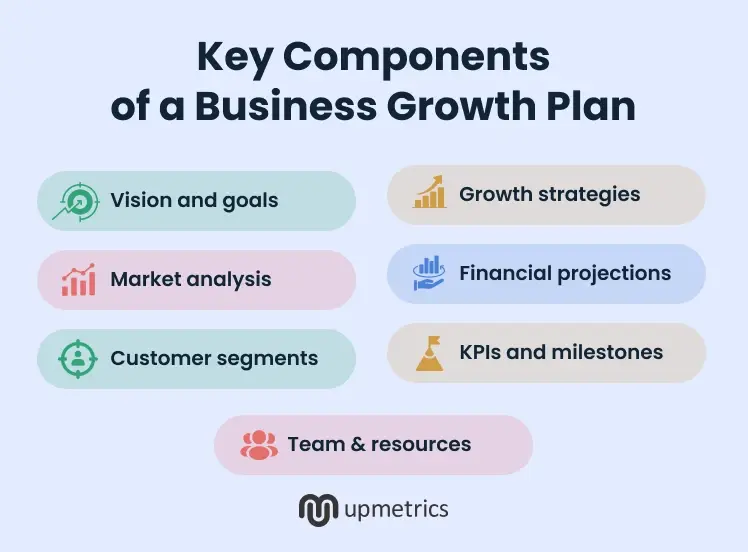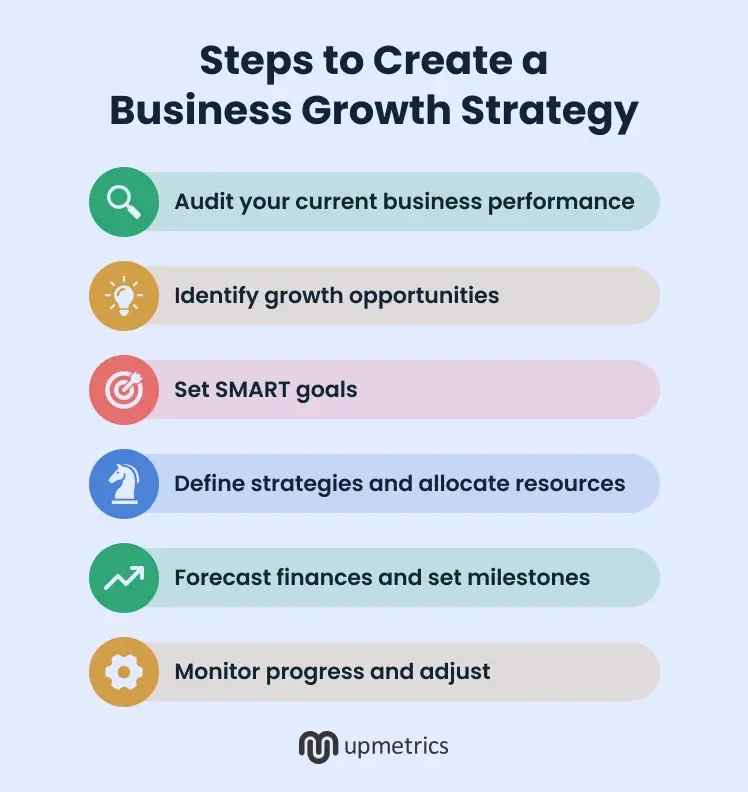It’s exciting (and a relief) when your new business is finally off the ground. But after that initial launch phase, what’s next?
Many business owners focus heavily on starting up, like writing a business plan, securing funding, and getting operations running, but hit a plateau when it’s time to plan for growth.
I quickly learned that having a clear business growth plan helps you set measurable goals, prioritize your next steps, and confidently make decisions.
It also directs your team and helps align your financial forecasting, marketing tactics, and customer retention strategies. This blog will walk through what a business growth plan includes, how to build one, and how to actually use it to grow your business with purpose.
Key Takeaways
- A business growth plan outlines your long-term vision and specific growth goals.
- It includes market analysis, identifying trends, potential new markets, customer base, and competitor landscape.
- The plan details strategies for achieving growth, such as marketing approaches, sales tactics, and product development.
- Regularly updating the growth plan ensures alignment with changing market conditions and business objectives.
What is a business growth plan?
A business growth plan is a clear, detailed strategy for expanding an existing business. It focuses on what’s already working and shows how you’ll build on it, whether that means growing revenue, entering new markets, launching new products, or scaling operations.
Unlike a startup plan, this one is about leveling up, not starting from zero. It includes updated goals, market research, sales and marketing tactics, financial projections, and any extra resources or team support you’ll need. It’s a working document you revisit and adjust as things evolve.
It turns your ideas into a structured, step-by-step plan. With clear targets and a step-by-step approach, your team knows what to work on, and you’re always prepared to explain the strategy when needed.
Is growth planning any different than traditional business planning?
You might be thinking, “I already wrote a business plan to get started—why do I need another one?” That’s a fair question, especially if you’re still wondering what a business plan is meant to do after launch
That original business plan was all about launching: Explaining what your business does, who you’re selling to, what your costs are, and how you plan to make money. It likely helped you get funding and figure out your early direction.
But once your business is up and running, things change.
- The market shifts.
- Customer needs evolve.
- And suddenly, that detailed startup plan isn’t as useful anymore.
That’s where a business growth plan comes in.
It’s not necessarily a replacement. It’s more like a continuation. Instead of asking “How will we start?”, it asks “Where do we go from here?” You’re now focused on scaling: entering new markets, launching products, boosting revenue, or improving retention.
And the format is much simpler. Many business owners keep it to a one-pager. You’re still working with key elements like financial projections and market research, but it’s more about quick updates and smart adjustments.
Knowing why you need a growth plan is one thing. Knowing what to put in it is the next step, and that’s where we’re headed now.
Key components of a business growth plan

While formats can vary, most business growth plans cover key components that work together to map out your growth strategy. Here are the core elements:
- Vision and goals: It outlines your long-term vision for the business and specific growth goals.
- Market analysis: This section explores the trends in your current market, potential new markets, customer base, and competitor landscape.
- Customer segments: This part revisits your current customers and identifies new types of buyers or demographics worth reaching.
- Growth strategies: This section shows how you’ll reach your goals, connecting the big picture to actionable steps.
- Financial projections: This section includes sales forecasts, expenses, and cash flow, giving you and potential investors a realistic view of what to expect.
- KPIs and milestones: This includes metrics like monthly revenue, customer acquisition, or site traffic, along with milestones—specific checkpoints that help you track progress and make adjustments when needed.
- Team & resources: This section explains who will do what, what skills or roles need to be added, and what resources are required to execute the plan.
Together, these elements give your growth plan the structure it needs to guide real progress.
Steps to create a business growth (plan) strategy
A business growth plan follows the same structure as a traditional business plan, just with a sharp focus on growth. You still include your executive summary, company background, market research, product strategy, financials, and operations.

But now, each section addresses how you’ll grow what you’ve already built. These are the steps that guide effective growth planning for any small business or existing business.
Step 1: Audit your current business performance
Start by taking a clear-eyed look at where your business stands right now. Think of it as a check-up on the health of your company, a necessary baseline before planning for business growth.
Review your recent sales figures, balance sheets, financial statements, customer feedback, and key performance metrics.
Ask questions like: What are your annual revenue and profit? How many active customers do you have? Which products or services are selling best?
Identify what’s working well and where your business is already having a positive impact. This helps guide future investment and focus.
For example, you might find that your customer churn rate is high or that a single product line generates 80% of your revenue.
These insights reveal both potential challenges that may slow progress and areas of strength you can build on. Maybe you need to improve retention. Maybe it’s time to diversify your offerings or target new segments of potential customers.
By auditing your current performance, you make sure your business growth strategy reflects real strengths and weaknesses. This is how you set a plan that fits your reality and gives your company a clear path forward.
Step 2: Identify growth opportunities
Now, look outward and forward. Based on your earlier audit and additional research, start to identify opportunities for expansion. This is where your business growth strategy starts to take shape.
Use market research to track industry trends and shifts in customer behavior and competitive analysis to understand what others in your space are doing and where they’re falling short.
Ask yourself:
- Are there untapped customer segments within your target market?
- Is there an upsell or product expansion opportunity you’re missing?
- Can you increase market share by doing something competitors aren’t?
Real-world examples help bring this step into focus. Maybe you’ve seen the growing interest in eco-friendly products. That could be your signal to explore a new product line. Or maybe you’ve noticed a spike in website traffic from a country you’re not even targeting yet. That might be a great chance to expand into a new region.
Take Shopify, for example. Their growth strategy includes moving into international markets and reaching new customer segments. It’s a reminder that even big players use data, not just instinct to guide their next moves.
So what about your business?
Now’s the time to jot down a few ideas of your own. They don’t need to be perfect. Just make sure they match your bigger vision and feel doable with your current team, tools, and budget.
This is the part where you throw around ideas, but not randomly. Use what your data’s already telling you. Maybe it’s time to launch something new, target a group you’ve overlooked, or put more energy into a channel that’s already picking up steam.
Whatever ideas you land on, focus on the ones that make the most sense for your business right now and that your team can actually act on. Ideas are great, but growth comes from execution
Step 3: Set SMART goals
Once you’ve identified your opportunities, the next step is to define exactly what you want to achieve. In other words, turn ideas into growth objectives.
To make them effective, use the SMART format—Specific, Measurable, Achievable, Relevant, and Time-bound. For example, don’t just write “increase sales.” A SMART goal would be: “Increase online sales by 30% in the next 12 months.”
That level of clarity turns your growth vision into something you can plan, track, and actually deliver. Your growth plan should include a mix of goals:
- Primary goals include revenue growth, expansion into a new market, and launching a new product line by Q3.
- Supporting goals like hiring five more employees and reducing customer acquisition costs by 15%.
Make sure these goals are realistic and backed by your earlier performance audit. They should stretch your business, but still be possible. You’re setting targets that your company can aim for and measure against.
Your goals are the anchor of your business growth plan. Every strategy, timeline, and budget decision you make will revolve around achieving them.
Step 4: Define strategies and allocate resources
Once your growth objectives are set, the next step is to figure out how you’ll achieve them. Goals define what you want, and strategies define how you’ll get there.
This is the core of your business growth plan: The actual initiatives and projects that will push the business forward. Every strategy should directly support a specific goal.
For example, if your goal is to expand into a new region, your strategies might include:
- Hiring a local sales representative
- Translating your website
- Running a region-specific marketing campaign
- If the aim is to increase customer retention, your strategies could involve
- Improving customer support response times
- Launching a loyalty or rewards program
Each action should be backed by a clear understanding of the resources it will require, whether that’s internal support or involving business partners to fill specific gaps.
This part of the plan is what connects strategy to execution. Without it, business owners often fall into the trap of setting ambitious revenue targets without a clear path to reach them.
A good growth plan describes what success looks like. It shows how you’ll get there and who will make it happen.
Step 5: Forecast finances and set milestones
This step connects directly to the financial section of your original business plan, but the focus now shifts from planning a launch to planning for business growth.
You’re not essentially starting from scratch. You’re updating your numbers based on new growth activities and strategies.
Use financial forecasting to model what will happen if your growth plan is successful.
Netflix has consistently used financial forecasting to guide growth, from predicting subscriber trends to planning international expansion. Their Q1 2025 earnings beat was no accident. It reflected accurate projections around content investments and market-specific growth targets
Forecasting helps you answer questions like: What revenue will the new product generate? How much will you need to invest in marketing or hiring? And most importantly, it gives you data to back those answers.
It also allows you to explore multiple outcomes: best case, worst case, and somewhere in between.
But numbers alone aren’t enough. Tie your forecast to specific, trackable milestones like mini-goals that mark progress toward your larger revenue targets, such as launching a new website, reaching break-even by a target date, and hitting $50K in monthly sales.
Setting these checkpoints helps ensure your plan stays grounded in reality and keeps your entire company focused on measurable results as you work to increase revenue.
Step 6: Monitor progress and adjust
A business growth plan is not a “set it and forget it” document. It should be a living guide that evolves with your company.
Once you start executing the plan, put a system in place to track your KPIs and measure progress against your milestones and goals. This might mean:
- Monthly KPI reports
- Quarterly strategy reviews
- Regular check-ins with department leads
Monitoring is essential. It shows you what’s working, what’s falling short, and where to identify opportunities for improvement.
You might discover that one strategy isn’t delivering results after three months, while another is outperforming expectations. That’s your cue to adjust the plan, such as shifting resources, refining tactics, or changing your focus entirely.
If the target audience shifts, a new competitor enters, or customer behavior changes, your plan should be flexible enough to adapt. That’s the strength of growth planning. You’re building a system that can move with the market, not against it.
This kind of agility is what separates a stagnant business from one that stays competitive.
In practice:
Treat your growth plan like a dynamic roadmap. Use it to steer your business, but stay ready to change course when needed. Early wins might even push you to set more ambitious targets. And when challenges arise, your updated plan helps you pivot faster.
But, remember:
Revisit your growth plan at least once a year, ideally every quarter. A stale strategy can become a liability. But a current one keeps your company focused, prepared, and aligned with real-world conditions.
Growth planning isn’t a one-time task.
It’s a repeatable cycle: Execute → Learn → Adjust.
That’s how long-term business growth happens on purpose and with a plan that stays relevant.
Start preparing your growth plan using Upmetrics
Writing a business growth plan doesn’t have to be complicated. With a clear structure and the right support, business owners can focus on setting growth goals, outlining revenue strategies, and planning what comes next without getting buried in spreadsheets.
A strong plan helps you stay focused, align your team, and move with clarity. It gives you a way to track progress, make better decisions, and respond quickly as things change.
And if you want a little help getting it all organized, a business planning tool like Upmetrics makes it easier to build, update, and share your growth plan, without overthinking the structure.



